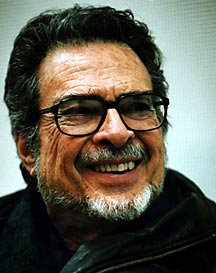Mozart and Bruckner with the BSO
 The Baltimore Symphony Orchestra brought this week's concert to the Music Center at Strathmore on Saturday night. With them came a Baltimore favorite, pianist Leon Fleisher, whose legacy as a celebrated teacher at the Peabody Institute extends throughout the musical world. For years Fleisher made a name for himself playing only repertoire for the left hand, after losing control of his right hand due to focal dystonia. Since a few years ago, when he recovered from that problem, Fleisher has enjoyed an Indian summer as a two-handed performer, most recently reviewed by Ionarts in a Shriver Hall recital last spring. For these concerts, Fleisher returned to the same composer, Mozart, he had played in his last appearance with the BSO. This time, he performed across from another pianist, Katherine Jacobson (who happens to be Fleisher's wife), in W. A. Mozart's concerto for two pianos (F major, K. 242).
The Baltimore Symphony Orchestra brought this week's concert to the Music Center at Strathmore on Saturday night. With them came a Baltimore favorite, pianist Leon Fleisher, whose legacy as a celebrated teacher at the Peabody Institute extends throughout the musical world. For years Fleisher made a name for himself playing only repertoire for the left hand, after losing control of his right hand due to focal dystonia. Since a few years ago, when he recovered from that problem, Fleisher has enjoyed an Indian summer as a two-handed performer, most recently reviewed by Ionarts in a Shriver Hall recital last spring. For these concerts, Fleisher returned to the same composer, Mozart, he had played in his last appearance with the BSO. This time, he performed across from another pianist, Katherine Jacobson (who happens to be Fleisher's wife), in W. A. Mozart's concerto for two pianos (F major, K. 242).
Tim Smith, Austrians' works showcase the power of harmony (Baltimore Sun, May 19) Ronni Reich, BSO With Leon Fleisher And Katherine Jacobson (Washington Post, May 21) |
 Jens has recently called Günther Herbig the "quintessential Kapellmeister," and indeed there is a certain reliability about his appearances with the BSO, most recently just this past March. This week's concert is a sequel of sorts, recreating the same formula from Herbig's very successful concert last year, which combined a Mozart horn concerto with Bruckner's 9th symphony. This time it was the Bruckner 7th, and one might hope that after these two installments, Herbig conducts the BSO in another Bruckner symphony each season. Alas, it is not to be, at least not next season, when the BSO will not play a single Bruckner symphony. With no score and podium between him and the BSO, the baton-wielding, patrician Herbig lovingly shaped the masses of Brucknerian harmony, what Jens has whimsically called "fluid architecture." With a gentle wag of a finger, Herbig often diluted the sound to the right level and drew an exultant, thunderous crescendo from the orchestra toward the end of the first movement.
Jens has recently called Günther Herbig the "quintessential Kapellmeister," and indeed there is a certain reliability about his appearances with the BSO, most recently just this past March. This week's concert is a sequel of sorts, recreating the same formula from Herbig's very successful concert last year, which combined a Mozart horn concerto with Bruckner's 9th symphony. This time it was the Bruckner 7th, and one might hope that after these two installments, Herbig conducts the BSO in another Bruckner symphony each season. Alas, it is not to be, at least not next season, when the BSO will not play a single Bruckner symphony. With no score and podium between him and the BSO, the baton-wielding, patrician Herbig lovingly shaped the masses of Brucknerian harmony, what Jens has whimsically called "fluid architecture." With a gentle wag of a finger, Herbig often diluted the sound to the right level and drew an exultant, thunderous crescendo from the orchestra toward the end of the first movement. The four Wagner tubas that Bruckner added to his orchestra, in honor of the composer he called "the Master," evoke Wagner's music in the Adagio. The sound in this performance was liquid and potent, especially in the end of the movement, which is a sort of funeral tribute to Wagner. The disputed cymbal crash was omitted from the end of the Adagio: while both sides of this editing controversy can be logically defended, the cymbal crash does stick out in a symphony that relies so little on percussion altogether. The third movement, which is marked Sehr schnell, seemed relaxed side and not that fast, while the fourth movement opened on the fast side of Bewegt, doch nicht schnell. This was a fine performance that held me spellbound, with excellent playing and Herbig's architectonic sense of structure. Jens, who is our resident Bruckner expert, has recommended the 7th symphony conducted by Günter Wand (on DVD), Karajan, Celibidache, and Philippe Herreweghe (yes, you read that correctly). You can listen online to portions of the fourth movement of the 7th symphony in this NPR piece about the Cleveland Symphony and Franz Welser-Möst.





















































No comments:
Post a Comment